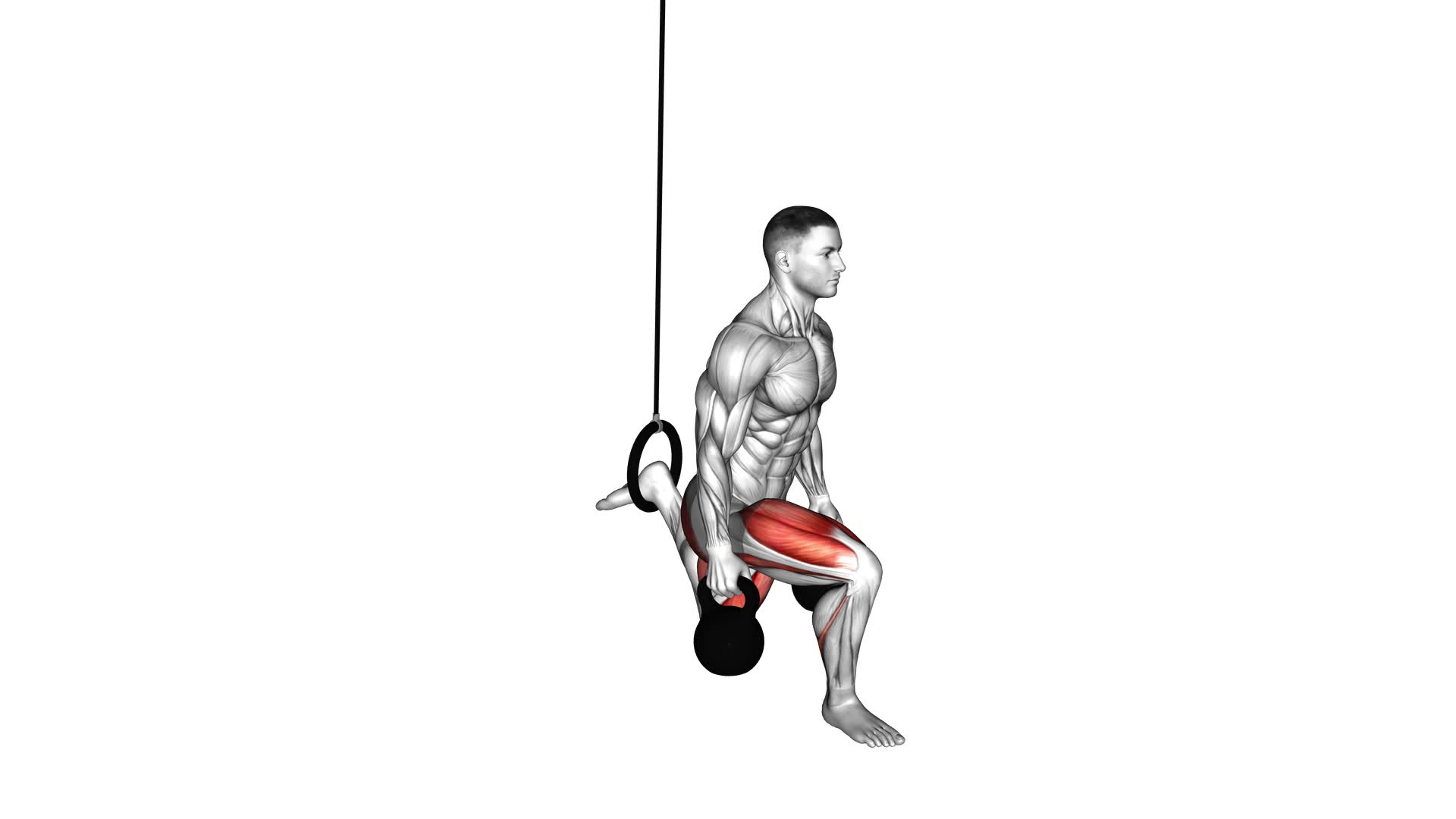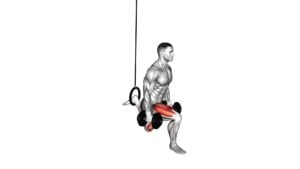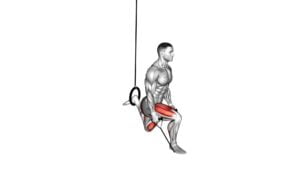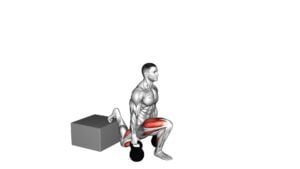Kettlebell Single Leg Split Squat With the Ring – Video Exercise Guide & Tips

Are you looking for a challenging lower body exercise that targets your glutes, quads, and hamstrings? Look no further than the kettlebell single leg split squat with the ring!
Watch This Exercise Video
This exercise combines the stability of the ring with the power of the kettlebell to give you a killer workout. In this article, we'll guide you through proper form and technique, provide modifications for all fitness levels, and share tips for maximizing your results.
Let's get started!
Key Takeaways
- Kettlebell Single Leg Split Squat improves lower body strength and stability.
- Alternatives to required equipment include bodyweight exercises and resistance band workouts.
- Proper form and technique are crucial for this exercise, including maintaining a stable stance and avoiding leaning forward.
- Beginners can start with lighter weights or no weight, while advanced individuals can increase kettlebell weight or add a plyometric element for greater intensity.
Benefits of Kettlebell Single Leg Split Squat
You will experience significant improvements in lower body strength and stability with the kettlebell single leg split squat. This exercise is a great way to target your quadriceps, glutes, and hamstrings while also challenging your balance and coordination. By performing this exercise with a kettlebell, you add an extra level of difficulty and engagement for your muscles. The kettlebell variations of the single leg split squat allow you to adjust the weight and intensity based on your fitness level and goals.
One of the main benefits of the kettlebell single leg split squat is that it helps to build unilateral leg strength. By focusing on one leg at a time, you can identify and correct any muscle imbalances or weaknesses. This can improve your overall performance in other exercises and activities, as well as reduce the risk of injuries.
Additionally, the single leg split squat requires a great amount of stability and control. It activates the stabilizer muscles in your hips, knees, and ankles, which can enhance your balance and coordination. This is especially beneficial for athletes, as well as individuals who want to improve their functional fitness and daily activities.
Incorporating kettlebell single leg split squats into your workout routine can be an effective way to enhance your lower body strength, stability, and overall fitness.
Equipment Needed for the Exercise
To perform the Kettlebell Single Leg Split Squat with the Ring, you'll need a few essential pieces of equipment.
First and foremost, you'll need a kettlebell of an appropriate weight for your fitness level.
Additionally, you'll need a sturdy exercise ring or suspension trainer to assist with balance and stability during the exercise.
If you don't have access to these specific pieces of equipment, there are alternative options that can be used as well.
Essential Equipment for Exercise
To successfully perform the Kettlebell Single Leg Split Squat with the Ring, it's important to have the essential equipment needed for the exercise.
Firstly, you should wear appropriate workout attire that allows for comfortable movement and flexibility. This includes breathable clothing and supportive athletic shoes to prevent any discomfort or injuries during the exercise.
Additionally, using an exercise mat is highly recommended to provide cushioning and support for your body while performing the split squat. The mat helps to reduce the impact on your joints and provides stability during the exercise.
Having the right equipment ensures a safe and effective workout, allowing you to focus on proper form and technique.
Alternatives to Required Equipment
To successfully perform the Kettlebell Single Leg Split Squat with the Ring, it's important to have the essential equipment needed for the exercise. But if you don't have access to the required equipment, there are some alternatives you can consider.
One option is to do bodyweight exercises that target similar muscle groups. Instead of using a kettlebell, you can perform a regular split squat without any added weight. This exercise still works your legs and glutes effectively.
Another alternative is to incorporate resistance band workouts into your routine. Resistance bands are affordable and versatile, allowing you to mimic the movements of the Kettlebell Single Leg Split Squat with the Ring. By using resistance bands, you can still challenge your muscles and achieve similar results without the need for specialized equipment.
Proper Form and Technique
Maintain a stable and balanced stance throughout the kettlebell single leg split squat exercise. This is crucial for proper form and technique. Common errors to avoid include leaning too far forward, which can put excessive strain on your knee and lower back. Another mistake is allowing your knee to go past your toes, which can also lead to injury. To prevent these errors, focus on keeping your chest up and your weight evenly distributed between your front and back leg.
There are also variations of the kettlebell single leg split squat that you can try to add variety to your workout routine. One option is to hold the kettlebell in a goblet position, which involves holding it at chest height with both hands. This variation can help to improve your upper body strength and stability.
Another variation is the kettlebell single leg split squat with the ring. This exercise involves holding the ring with both hands while performing the split squat. It adds an additional challenge to your balance and stability.
Modifications for Beginners and Advanced
As you progress in your kettlebell single leg split squat exercise, you can make modifications to either challenge yourself further or make it more beginner-friendly.
For beginners, it's important to start with lighter weights or no weight at all to focus on proper form and stability. You can also use a chair or a wall for support while performing the exercise. This will help you build strength and balance before progressing to more advanced variations.
To make the exercise more challenging, advanced modifications can be implemented. One option is to increase the weight of the kettlebell you're using. This will require more strength and stability from your working leg and core muscles.
Another advanced modification is to add a plyometric element to the exercise. Instead of simply standing up from the split squat position, you can explosively jump off the ground using your working leg. This will further engage your muscles and increase the intensity of the exercise.
Remember to always listen to your body and progress at your own pace. It's important to maintain proper form and avoid any pain or discomfort. By incorporating beginner modifications or advancing to more challenging variations, you can continue to challenge yourself and make progress in your kettlebell single leg split squat exercise.
Common Mistakes to Avoid
When performing the kettlebell single leg split squat with the ring, it's important to be aware of common mistakes to avoid in order to maximize the effectiveness of the exercise. Here are four common mistakes to watch out for:
- Improper knee alignment: Ensure that your knee is directly over your ankle and not collapsing inward. This will help prevent knee strain and injury.
- Lack of stability: Maintain a stable and balanced position throughout the exercise. Engage your core muscles and focus on keeping your body upright to avoid leaning forward or sideways.
- Incorrect depth: Avoid going too deep into the squat, as this can put excessive strain on your knee and hip joints. Aim to lower your body until your back knee is just above the ground and maintain control throughout the movement.
- Neglecting the ring: The ring serves as a support and helps with balance during the exercise. Make sure to grip the ring firmly and use it to assist your stability and control as you perform the single leg split squat.
Tips for Maximizing Your Results
To maximize your results, incorporate these three tips into your kettlebell single leg split squat with the ring routine.
First, focus on maintaining proper form throughout the exercise. Keep your back straight, chest lifted, and core engaged. This will help target the muscles in your glutes, quads, and hamstrings more effectively.
Second, use a challenging weight that allows you to perform the exercise with proper form, but also pushes your muscles to work harder. Gradually increase the weight as you become stronger and more comfortable with the movement.
Finally, vary your tempo and technique. This can be done by performing the exercise at a slow and controlled pace, or by incorporating pauses and pulses at different points in the movement. Changing up your tempo and technique won't only keep your workouts interesting, but also challenge your muscles in different ways, leading to better overall results.
Frequently Asked Questions
How Many Sets and Reps Should I Do for the Kettlebell Single Leg Split Squat?
To determine the number of sets and reps for the kettlebell single leg split squat, consider your fitness level and goals.
Start with 2-3 sets of 8-12 reps per leg. This will help build strength and stability.
As you progress, you can increase the number of sets or reps to challenge yourself further.
Remember to listen to your body and adjust as needed.
Consult with a fitness professional for personalized guidance.
Can I Use Dumbbells Instead of Kettlebells for This Exercise?
Yes, you can definitely use dumbbells instead of kettlebells for this exercise. Using dumbbells for kettlebell exercises is a great alternative.
The benefits of single leg exercises, like the split squat, include improved balance, stability, and strength in your lower body.
Dumbbells can provide the same benefits as kettlebells, so feel free to grab a pair and give it a try.
Just make sure to maintain proper form and challenge yourself with an appropriate weight.
Is It Necessary to Use the Ring for This Exercise, or Can I Perform It Without It?
Yes, you can perform the kettlebell single leg split squat without the ring. However, using the ring has its benefits.
It helps improve stability, engages more muscles, and adds an extra challenge to your workout.
If you don't have a ring, you can modify the exercise by holding dumbbells or using a stability ball for support.
Remember to maintain proper form and gradually increase the weight or difficulty for better results.
Are There Any Specific Warm-Up Exercises I Should Do Before Attempting the Kettlebell Single Leg Split Squat?
Before attempting the kettlebell single leg split squat, it's important to do specific warm-up exercises to prepare your body. These exercises can include dynamic stretches, such as leg swings and hip circles, to loosen up your muscles and increase range of motion.
Additionally, you may want to do some activation exercises, like glute bridges or lateral lunges, to activate the muscles you'll be using during the split squat.
These warm-up exercises will help prevent injury and improve your performance.
Can I Incorporate This Exercise Into My Lower Body Workout Routine, or Should It Be Done on Its Own?
You can definitely incorporate this exercise into your lower body workout routine.
It's a great addition to your routine because it targets your lower body muscles in a unilateral way, which can help improve your overall lower body strength and stability.
By incorporating other unilateral exercises into your routine, you can further enhance the benefits of single leg exercises.
Conclusion
In conclusion, the kettlebell single leg split squat with the ring is a highly effective exercise for strengthening the lower body and improving balance.
By using proper form and technique, you can maximize your results and avoid common mistakes.
Whether you're a beginner or advanced, there are modifications available to suit your fitness level.
Incorporating this exercise into your routine with the right equipment can lead to great benefits for your overall fitness and strength.

Author
Years ago, the spark of my life’s passion ignited in my mind the moment I stepped into the local gym for the first time. The inaugural bead of perspiration, the initial endeavor, the very first surge of endorphins, and a sense of pride that washed over me post-workout marked the beginning of my deep-seated interest in strength sports, fitness, and sports nutrition. This very curiosity blossomed rapidly into a profound fascination, propelling me to earn a Master’s degree in Physical Education from the Academy of Physical Education in Krakow, followed by a Sports Manager diploma from the Jagiellonian University. My journey of growth led me to gain more specialized qualifications, such as being a certified personal trainer with a focus on sports dietetics, a lifeguard, and an instructor for wellness and corrective gymnastics. Theoretical knowledge paired seamlessly with practical experience, reinforcing my belief that the transformation of individuals under my guidance was also a reflection of my personal growth. This belief holds true even today. Each day, I strive to push the boundaries and explore new realms. These realms gently elevate me to greater heights. The unique combination of passion for my field and the continuous quest for growth fuels my drive to break new ground.







